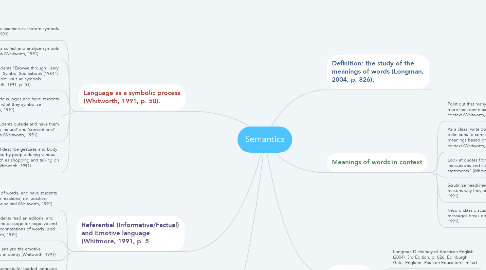Semantics
by Stefanie Napolitan


1. Language as a symbolic process (Whitworth, 1991, p. 50).
1.1. Have students examine classroom symbols (Whitworth, 1991).
1.2. Have students collect and analyze symbols in comic strips (Whitworth, 1991).
1.3. Have students "Browse through Henry Dreyfuss' Symbol Sourcebook (1984"), and explore unusual symbols (Whitworth, 1991, p. 51).
1.4. Collect various logos and have students determine what they symbolize (Whitworth, 1991).
1.5. Take students outside and have them observe 'natural' and 'conventional' symbols (Whitworth, 1991).
1.6. Observe and describe gestures and body language used by people during various activities, such as shopping and talking on the phone (Whitworth, 1991).
2. Referential (Informative/Factual) and Emotive language (Whitmore, 1991, p. 5
2.1. Read a list of words, and have students record their reactions, i.e. positive, negative, or neutral (Whitworth, 1991).
2.2. Have students read an editorial and analyze the passage for negative and positive connotations of words used (Whitworth, 1991).
2.3. Have students analyze the emotive language used in poetry (Whitworth, 1991).
2.4. Study advertisements for loaded language (Whitworth, 1991).
3. Relationships between Language and Thinking (Analyzing, Synthesizing, Inferring, and Evaluating) (Whitworth, 1991, p. 53).
3.1. Have students classify/categorize several items and discuss how we determine categories (Whitworth, 1991).
3.2. Have students "study jokes, noting how humor is often dependent on sudden and unexpected shifts in classifications" (Whitworth, 1991, p. 53).
3.3. Have students view various photographs/images, and have them select some that they see a relationship. From here, have them create a storyboard (Whitworth, 1991).
3.4. Have students examine contradictory proverbs, and discuss whether or not the contradictions can be resolved or explained (Whitworth, 1991).
4. Definition: the study of the meanings of words (Longman, 2004, p. 826).
5. Meanings of words in context
5.1. Point out that many of our words have more than one meaning, depending on context (Whitworth, 1991, pp. 51-52).
5.1.1. Students can use dictionaries "devise similar multi-variant references" for words (Whitworth, 1991, p. 52)

